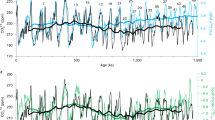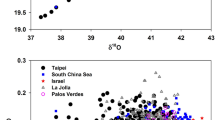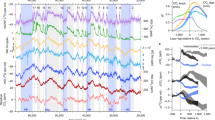Abstract
The stable isotope ratios of atmospheric CO2 (18O/16O and 13C/12C) have been monitored since 1977 to improve our understanding of the global carbon cycle, because biosphere–atmosphere exchange fluxes affect the different atomic masses in a measurable way1. Interpreting the 18O/16O variability has proved difficult, however, because oxygen isotopes in CO2 are influenced by both the carbon cycle and the water cycle2. Previous attention focused on the decreasing 18O/16O ratio in the 1990s, observed by the global Cooperative Air Sampling Network of the US National Oceanic and Atmospheric Administration Earth System Research Laboratory. This decrease was attributed variously to a number of processes including an increase in Northern Hemisphere soil respiration3; a global increase in C4 crops at the expense of C3 forests4; and environmental conditions, such as atmospheric turbulence5 and solar radiation6, that affect CO2 exchange between leaves and the atmosphere. Here we present 30 years’ worth of data on 18O/16O in CO2 from the Scripps Institution of Oceanography global flask network and show that the interannual variability is strongly related to the El Niño/Southern Oscillation. We suggest that the redistribution of moisture and rainfall in the tropics during an El Niño increases the 18O/16O ratio of precipitation and plant water, and that this signal is then passed on to atmospheric CO2 by biosphere–atmosphere gas exchange. We show how the decay time of the El Niño anomaly in this data set can be useful in constraining global gross primary production. Our analysis shows a rapid recovery from El Niño events, implying a shorter cycling time of CO2 with respect to the terrestrial biosphere and oceans than previously estimated. Our analysis suggests that current estimates of global gross primary production, of 120 petagrams of carbon per year7, may be too low, and that a best guess of 150–175 petagrams of carbon per year better reflects the observed rapid cycling of CO2. Although still tentative, such a revision would present a new benchmark by which to evaluate global biospheric carbon cycling models.
This is a preview of subscription content, access via your institution
Access options
Subscribe to this journal
Receive 51 print issues and online access
$199.00 per year
only $3.90 per issue
Buy this article
- Purchase on Springer Link
- Instant access to full article PDF
Prices may be subject to local taxes which are calculated during checkout




Similar content being viewed by others
References
Keeling, C. D. et al. in A History of Atmospheric CO2 and Its Effects on Plants, Animals, and Ecosystems (eds Ehleringer, J. R., Cerling, T. E. & Dearing, M. D. ) 83–113 (Springer, 2005)
Farquhar, G. D. et al. Vegetation effects on the isotope composition of oxygen in atmospheric CO2 . Nature 363, 439–443 (1993)
Ishizawa, M., Nakazawa, T. & Higuchi, K. A multi-box model study of the role of the biospheric metabolism in the recent decline of δ18O in atmospheric CO2 . Tellus B 54, 307–324 (2002)
Gillon, J. & Yakir, D. Influence of carbonic anhydrase activity in terrestrial vegetation on the 18O content of atmospheric CO2 . Science 291, 2584–2587 (2001)
Lee, X. H. et al. Canopy-scale kinetic fractionation of atmospheric carbon dioxide and water vapor isotopes. Glob. Biogeochem. Cycles 23, GB1002 (2009)
Still, C. J. et al. Influence of clouds and diffuse radiation on ecosystem-atmosphere CO2 and CO18O exchanges. J. Geophys. Res. 114, G01018 (2009)
Beer, C. et al. Terrestrial gross carbon dioxide uptake: global distribution and covariation with climate. Science 329, 834–838 (2010)
Zhao, M. S., Heinsch, F. A., Nemani, R. R. & Running, S. W. Improvements of the MODIS terrestrial gross and net primary production global data set. Remote Sens. Environ. 95, 164–176 (2005)
Ciais, P. et al. A three-dimensional synthesis study of δ18O in atmospheric CO2. 1. Surface fluxes. J. Geophys. Res. 102, 5857–5872 (1997)
Cuntz, M., Ciais, P., Hoffmann, G. & Knorr, W. A comprehensive global three-dimensional model of δ18O in atmospheric CO2: 1. Validation of surface processes. J. Geophys. Res. 108, 4527 (2003)
Dai, A. & Wigley, T. M. L. Global patterns of ENSO-induced precipitation. Geophys. Res. Lett. 27, 1283–1286 (2000)
Gat, J. R., Mook, W. G. & Meijer, H. A. J. Environmental Isotopes in the Hydrological Cycle, Volume II: Atmospheric Water 55, 56 (UNESCO/IAEA, 2001)
Curtis, S. & Adler, R. ENSO indices based on patterns of satellite-derived precipitation. J. Clim. 13, 2786–2793 (2000)
Yoshimura, K., Kanamitsu, M., Noone, D. & Oki, T. Historical isotope simulation using reanalysis atmospheric data. J. Geophys. Res. 113, D19108 (2008)
Allison, C. E. & Francey, R. J. Verifying Southern Hemisphere trends in atmospheric carbon dioxide stable isotopes. J. Geophys. Res. 112, D21304 (2007)
Assonov, S. S., Brenninkmeijer, C. A. M., Schuck, T. J. & Taylor, P. Analysis of 13C and 18O isotope data of CO2 in CARIBIC aircraft samples as tracers of upper troposphere/lower stratosphere mixing and the global carbon cycle. Atmos. Chem. Phys. 10, 8575–8599 (2010)
Ebisuzaki, W. A method to estimate the statistical significance of a correlation when the data are serially correlated. J. Clim. 10, 2147–2153 (1997)
Takahashi, T. S. et al. Climatological mean and decadal changes in surface ocean pCO2, and net sea-air CO2 flux over the global oceans. Deep-Sea Res. II 56, 554–577 (2009)
Randerson, J. T., Thompson, M. V., Conway, T. J., Fung, I. Y. & Field, C. B. The contribution of terrestrial sources and sinks to trends in the seasonal cycle of atmospheric carbon dioxide. Glob. Biogeochem. Cycles 11, 535–560 (1997)
Appenzeller, C., Holton, J. R. & Rosenlof, K. H. Seasonal variation of mass transport across the tropopause. J. Geophys. Res. 101, 15071–15078 (1996)
Montzka, S. A. et al. On the global distribution, seasonality, and budget of atmospheric carbonyl sulfide (COS) and some similarities to CO2 . J. Geophys. Res. 112, D09302 (2007)
Wingate, L. et al. The impact of soil microorganisms on the global budget of δ18O in atmospheric CO2 . Proc. Natl Acad. Sci. USA 106, 22411–22415 (2009)
Cobb, K. M., Adkins, J. F., Partin, J. W. & Clark, B. Regional-scale climate influences on temporal variations of rainwater and cave dripwater oxygen isotopes in northern Borneo. Earth Planet. Sci. Lett. 263, 207–220 (2007)
Vuille, M. & Werner, M. Stable isotopes in precipitation recording South American summer monsoon and ENSO variability: observations and model results. Clim. Dyn. 25, 401–413 (2005)
Thompson, L. G. Ice core evidence for climate change in the Tropics: implications for our future. Quat. Sci. Rev. 19, 19–35 (2000)
Evans, M. N. Toward forward modeling for paleoclimatic proxy signal calibration: a case study with oxygen isotopic composition of tropical woods. Geochem. Geophys. Geosyst. 8, Q07008 (2007)
Willett, K. M., Jones, P. D., Gillett, N. P. & Thorne, P. W. Recent changes in surface humidity: development of the HadCRUH dataset. J. Clim. 21, 5364–5383 (2008)
Hoag, K. J., Still, C. J., Fung, I. Y. & Boering, K. A. Triple oxygen isotope composition of tropospheric carbon dioxide as a tracer of terrestrial gross carbon fluxes. Geophys. Res. Lett. 32, L02802 (2005)
Bollenbacher, A. F. et al. Calibration Methodology for the Scripps 13C/12C and 18O/16O Stable Isotope Program 1992–1996: a Report Prepared for the Global Environmental Monitoring Program of the World Meteorological Organization (Scripps Institution of Oceanography, 2000)
Keeling, C. D. et al. Exchanges of Atmospheric CO2 and 13CO2 with the Terrestrial Biosphere and Oceans from 1978 to 2000. I. Global Aspects. SIO Reference No. 01–06 (Scripps Institution of Oceanography, 2001)
Acknowledgements
The authors thank S. Walker for programming assistance and all those involved with flask collection and analysis. This work was supported by the US National Science Foundation (NSF) under grant ATM06-32770, by the US Department of Energy (DOE) under grant DE-SC0005099 and by the US National Aeronautics and Space Administration (NASA) under grant NNX11AF36G. Any opinions, findings and conclusions or recommendations expressed in this material are those of the authors and do not necessarily reflect the views of NSF, DOE or NASA.
Author information
Authors and Affiliations
Contributions
L.R.W. analysed the data. R.F.K. supervised the project. L.R.W. and R.F.K. wrote the paper. H.A.J.M., A.F.B., R.J.F., C.E.A. and M.W. provided data. K.Y. provided the IsoGSM output. All authors discussed the results and commented on the manuscript.
Corresponding authors
Ethics declarations
Competing interests
The authors declare no competing financial interests.
Supplementary information
Supplementary Information
This file contains Supplementary Text 1-6, which includes a Supplementary Discussion and Supplementary Methods, Supplementary References, Supplementary Figure 1 with a legend and Supplementary Tables 1-3. (PDF 1630 kb)
Rights and permissions
About this article
Cite this article
Welp, L., Keeling, R., Meijer, H. et al. Interannual variability in the oxygen isotopes of atmospheric CO2 driven by El Niño. Nature 477, 579–582 (2011). https://doi.org/10.1038/nature10421
Received:
Accepted:
Published:
Issue Date:
DOI: https://doi.org/10.1038/nature10421
This article is cited by
-
New constraints of terrestrial and oceanic global gross primary productions from the triple oxygen isotopic composition of atmospheric CO2 and O2
Scientific Reports (2023)
-
Historically inconsistent productivity and respiration fluxes in the global terrestrial carbon cycle
Nature Communications (2022)
-
Leaf scale quantification of the effect of photosynthetic gas exchange on Δ47 of CO2
Scientific Reports (2021)
-
Increase in summer monsoon rainfall over the northeast India during El Niño years since 1600
Climate Dynamics (2021)
-
Large-scale climate indices teleconnections with hydrochemical and isotopic characteristics of a karst spring using wavelet analysis
Environmental Earth Sciences (2021)
Comments
By submitting a comment you agree to abide by our Terms and Community Guidelines. If you find something abusive or that does not comply with our terms or guidelines please flag it as inappropriate.



